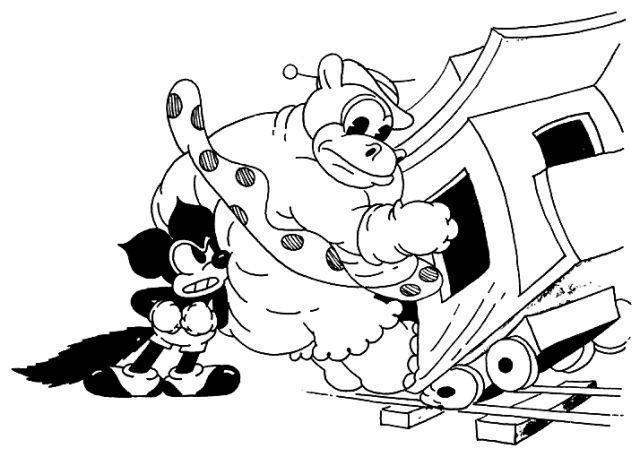|
Jump to: Introduction | History | Recent Updates | Links Welcome to Looney Tunes & Merrie Melodies: The Early Years. This site acts as a database of information for the Warner Bros. cartoons of 1930 to 1933. Here you will find plot descriptions, screen shots, and other bits of info on the many cartoons listed, histories and filmographies of the various characters, and information on the men who created them. Since this is a database, the information is complete only through the most recent cartoon added. Eventually all of the cartoons from this period will be listed, and perhaps even some of the ones created after. Check back regularly to see what’s been added. Use the side bar found on each page to navigate through site, and make sure to read the FAQ if you have any questions. ![A promotional drawing for Sinkin' in the Bathtub [TAF!]](https://looneytunes.popgeeks.com/wp-content/uploads/2014/07/sinkin-in-the-bathtub-150x112.jpg) A promotional drawing for Sinkin’ in the Bathtub [TAF!] Seventy years ago, in April of 1930, the first Looney Tunes cartoon was released. It was an eight minute musical adventure called Sinkin’ in the Bathtub, starring two new characters named Bosko and Honey. Hugh Harman and Rudolf Ising — two ex-Disney animators — partnered with producer Leon Schlesinger to create the cartoon, which was distributed by Warner Bros. Pictures. None of them could have imagined that seventy years later this cartoon would be considered a milestone in animation history. They would never have believed that anyone would still care after all these years. Yet that cartoon, and the hundreds which followed, have left behind an enduring legacy. It all started, as most Hollywood animation did, in the works of Walt Disney. Harman and Ising had worked with Disney since the early 1920s, but by the summer of 1929 they and a group of other ex-Disney animators were out on their own and looking to start a new cartoon studio. They created a pilot film called Bosko the Talk-Ink Kid, which was one of the first cartoons to feature synchronized speech. The pilot impressed Leon Schlesinger, and he managed to convince Warner Bros. to distribute a series of cartoons starring the Bosko character. They called this new series “Looney Tunes”, obviously deriving the name from Disney’s “Silly Symphonies”series. Bosko starred with his girlfriend Honey, and soon a dog named Bruno joined them;again, deriving the formula from that of Disney’s Mickey, Minnie and Pluto. These cartoons were imaginative, though a bit repetitive, and come across as very surreal to modern audiences. Bosko proved his versatility by starring as everything from a hot dog vendor to a lumberjack to a World War I aviator. After producing one Looney Tune a month for a year, a second series of cartoons called “Merrie Melodies”was created. ![A promotional drawing for Smile, Darn Ya, Smile! [OM&M]](https://looneytunes.popgeeks.com/wp-content/uploads/2014/07/smile-darn-ya-smile-150x112.jpg) A promotional drawing for Smile, Darn Ya, Smile! [OM&M] The Merrie Melodies cartoons were designed to showcase songs from Warner Bros’ vast music library. The title of each cartoon was also the title of the song featured in it. Some, like Smile, Darn Ya, Smile!, incorporated the song into the action effortlessly, creating a highly enjoyable mix of the two. Others were not so successful, and felt more like characters standing around and singing for no reason. Attempts were made to create new starring characters, but none of them lasted. These characters include Foxy &Roxy (the most blatant of the Mickey and Minnie rip-offs), a pair of pigs named Piggy &Fluffy, and a dog named Goopy Geer. The Merrie Melodies soon became a series of one-shot cartoons, with no common thread linking them except for the focus on music. After creating thirty-nine Looney Tunes and twenty-seven Merrie Melodies, Harman and Ising left over a budget dispute with Leon Schlesinger. They took Bosko and Honey with them to MGM, where they started the “Happy Harmonies”series. Most of the staff would soon return to Schlesinger however, and eventually this group (which included Chuck Jones, Bob Clampett, Friz Freleng, and Robert McKimson) would go on to help create some of the most beloved cartoon characters of all-time… but first they had to find a way to survive with no star and no direction. But that’s a story to be told at another time. [TAF! and OM&M] For more detailed information on the formation of the Warner Bros. cartoon studio, I highly recommend reading the book Hollywood Cartoons by Michael Barrier.
Here are some other sites that should be of interest if you want to learn more about these cartoons. |
